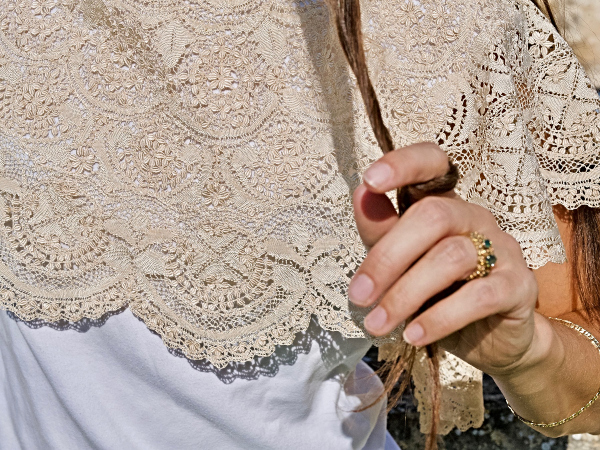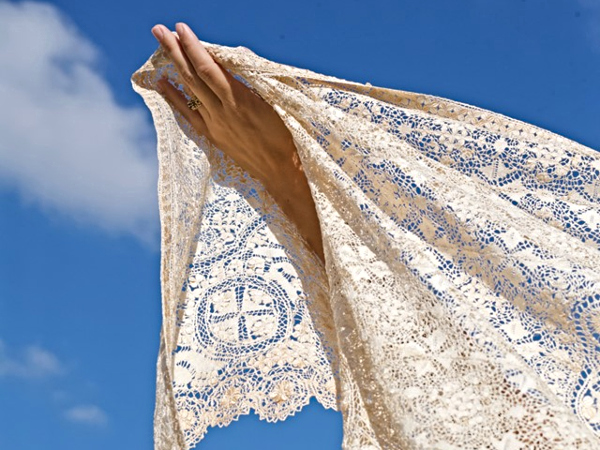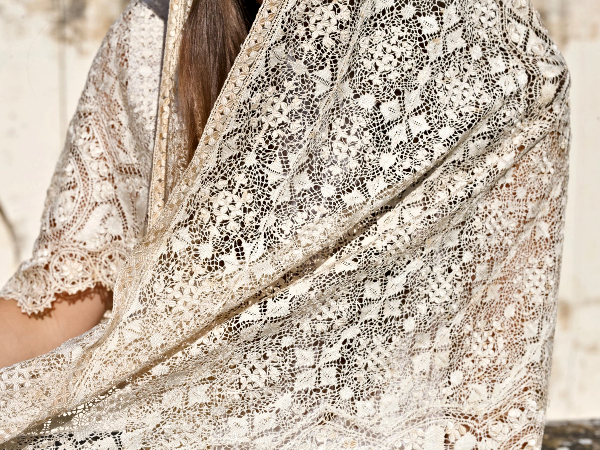Bringing Maltese Lace Making Back To Life
Let’s talk lace! Maltese lace making is unfortunately dying trade as many other traditional craftsmanship. Luckily there is HAJJA (meaning life in Maltese). HAJJA is a social enterprise that aims to revive the dying Maltese lace making tradition of Bizilla. How? Through connecting communities & stories, sharing skills and empowering cultural identity in a fairly produced way.
However, before I talk more about HAJJA and their lace making workshops, let’s look a little bit into the history of lace making in Malta.

History of lace making in Malta
The Maltese word for lace making is ‘il-bizilla’. History of lace making goes all the way to the 16th century when pillow lace was created in the Italian city of Genoa. Lace was introduced in Malta by the Order of St John around 1640. There was a high demand by the knights, the clergy and the members of the Maltese aristocracy. Which led to a significant increase in lace makers.
It continued to flourish until the end of 18th century, when the Maltese islands were taken over by Napoleon Bonaparte. During the French occupation, lace making almost died out. Luckily that didn’t happen thanks to Lady Hamilton Chichester, who took a great interest in Maltese lace. She did her utmost to revive lace making by Geonese lace weavers to the islands.

The more recent history of lace making goes back to the 19th century. The story says that a piece of lace from Genoa was given to Marjana Attard, a Gozitan woman, by a member of the clergy, Fr Gwann Curmi. She studied the pattern of lace very carefully, started to copy it. She thought herself, her sister as well as other friends.
And just like that the skill of lace making was born in Gozo. It became very popular among the Gozitan women and girls as well as the Gozitan clergy. The lace was used to enrich the sacred vestments and church furnishings.
The Gozitans were not only producing lace, but also creating their own stitches. The demand for lace was so great that even schools of lace opened in the capital city Victoria.

While doing my research I also came across the term ‘bobbin lace’ or ‘bobbin lace making’ several times. Which basically refers to how the Maltese lace is made. Using bobbins (combini), which are small wooden ‘sticks’. The bobbins are usually made of fruit tree wood. It is worthwhile to mention that in olden days bobbins were also made of bones! If you would like to learn more about the history of lace making in Malta and Gozo, check out this paper!

Lace making: what do you need?
After some theory and history of lace making let’s start with the practical part. The first thing you get is couple of bobbins and threads. You have to wound the thread around the upper part of the bobbin. This method helps the lace maker to manipulate the thread better around the bobbins (combini). One can find different types of threads used in lace making in Malta. Some use silk and others use fine linen.

The thread can we wound around the bobbin manually or using the bobbin winder (below), which is obviously much more time efficient.

This 3 hour workshop was led by Anna Brincat who has many years of experience in lace making. Her inspiration derived from her grandmother, while watching her working lace. Throughout the years, Anna Brincat attended many seminars and workshops to widen her knowledge and even represented lace makers in Sardinia. She is also currently attending a course of ‘Diploma in Lace Studies’ in Gozo. Anna is the perfect guide to start your lace making journey! And super patient with my slow learning haha!

Lace is made on a ‘pillow’ which is locally known as ‘trajbu’. Interestingly enough, the Maltese word ‘trajbu’ is derived from the Maltese word ‘tarbija’ a baby, suggesting that lace making is a labour of love. And how is it made?
This pillow is about 60cm long and made out of a bundle of dry straw stalks. The bundle is then wrapped up in a piece of hessian cloth and sewn up tightly. Then it is covered with cotton, several sheets of newspaper and flour paste. After drying in the sun is finally covered in strong brown paper. When the ‘trajbu’ is ready the pattern is pinned to the upper end as you can see below.

Let’s lace!
At this point we got the pillow (trajbu) and the bobbins ready so we can start some lace making! The first step is to place number of pins at the very top of the pattern. The next step is to ‘hang’ the bobbing on each pin. And then you start lace making, working with 4 bobbins at the same time following a ‘basic’ lace pattern. At the end of each row the lace is secured with another pin.


It’s not very complicated, but at the beginning I found it a bit confusing. Once I got the hang of it it was actually enjoyable and somehow relaxing. It’s important you sit comfortably and resting your back as otherwise you get tired quickly. Oliver made sure I took regular breaks though. Haha! I think it did take good 2 hours to make this strip of lace.

Why should you learn lace making?
The workshops are a nice experience and you learn something new. You share your skills and stories. You meet new people. But what you might not know, when you attend one of these workshops you don’t only empower cultural identity, you also support a person. How is that? Your money from the registration fee will help funding a 6 month course for a marginalized person! Isn’t that awesome?
The idea is that after they finish the 6 month course, they will be ‘Hajja Certified’ and they will be paid for the lace they produce. The courses are in collaboration with different NGO’s – the people will ‘heal’ through lace making and at the same time, they will be able to get a source of income out of it, just like the olden days.
So let’s summarize. By attending one or more of HAJJA’s workshops you 1) meet new people, 2) learn something new, 3) get a nice bow decorated with your own lace 4) support the revival of Maltese lace, 5) help a person in need. Do you need another reason to attend?


Lace making workshops. What to expect?
These lace making workshops organised by HAJJA can host about 7 people to ensure a lot of one on one attention. So far they are oganised once a month. The workshops are always designed to learn 1 of the basic 8 stitches. So if you attend more then one workshop you don’t have to worry that it would be always the same.
When attending one of these workshops you will be provided with everything you need for lace making. Water is served through out the class to make sure everyone is hydrated and can concentrate on lace making. 🙂


Done all the workshops? What’s next?
Have you attended like 8 workshops, learned and mastered all the basic stitches and want to take it to the next level? Well, this being the second workshop that HAJJA organised, it will be the end of 2019 by the time you get to this point. And from 2020 HAJJA is hoping to be organising 6 month courses. For now they are trying to collect enough funds to make it happen. They are also in the semi-finals of Malta Social Impact Awards 2019! Best of luck guys!


#iknowwhomademybow movement
Have you heard about the Fashion Revolution global movement with the hashtag #whomademyclothes? The aim is to unite people and organisations to work together towards radically changing the way our clothes are sourced, produced and consumed, so that our clothing is made in a safe, clean and fair way.
This global movement organises a Fashion Revolution Week, which is their #whomademyclothes campaign in April. During this week, brands and producers are encouraged to respond with the hashtag #imadeyourclothes and to demonstrate transparency in their supply chain.

Transparency is also one of HAJJA’s key attributes. Their production is very transparent. Bibiche Rath, the founder, taught herself to sew and she produces the bows herself, one by one. Another important side note is that they don’t waste. The left over Spanish silk thread of the bobbin after the class, is used to put the bows together and the lace decorating the bow is handmade by their lacemakers / changemakers themselves.
Apart from the production transparency and sustainability commitments, they connect makers with consumers. There is a unique story with every bow you buy and soon you will be able to trace this on their website. You will be able to virtually meet the maker, really find out WHO made your lace, where and why! That’s why #iknowwhomademybow!

Did I mention that during our last lace making workshop, which was held at Casa Rocca Piccola, we were joined by the owner himself! Mr Nicholas de Piro (full name: Nicholas 9th Baron of Budach and 9thMarquis de Piro) joined us for an informal chat about lace making and his great lace collection. He possess arguably the largest collection of lace on the Maltese Islands! Perfect place for lace making isn’t it!

Mr de Piro is photographed with the founder of HAJJA Bibiche Rath. Bibiche has been living in Malta since 2011. She loves vintage, traditions, basically anything old school. Bibiche has always worked within the fashion industry, since she is really fascinated with both clothes and fabrics. But why lace and lace making?
Bibiche has always loved the traditional craft. She started the workshops and is planning courses because she wants to give people purpose. Especially after realizing that lacemaking works therapeutically.
What’s the big dream for HAJJA?
Hajja is a social enterprise that wants to give Bizzilla new life in a modern way and at the same time, make a positive impact on someone’s life. The big dream is that there are lace cafes all over Malta, where people would meet, get in touch with the moment, in touch with themselves and at the same time produce lace for these beautiful cultural masterpieces; The Hajja bow. That it would be a source of income too, like the olden days.
This beautiful lace bow could be worn by little girls for their baptism, holy communion wedding or any other special occasion. A bow of skills & stories, that will be passed down through generations to come! Let’s keep the lace alive, TOGETHER!
Join HAJJA for their next workshop during Malta Artisan Market on the 20th and 21st July 2019 at Palazzo Parisio in Naxxar!



